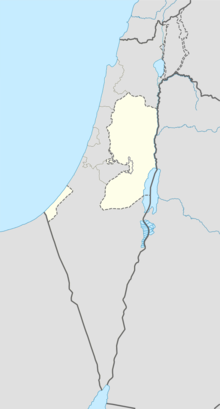Tirzah (ancient city)
| תרצה/תל אל-פארעה | |
| Location | West Bank |
|---|---|
| Coordinates | 32°17′15″N 35°20′16″E / 32.287387°N 35.337803°E |
| Area | 180 dunam 0.18 km² |
| History | |
| Periods | Bronze Age, Iron Age |
Tirzah (Hebrew: תִּרְצָה) was a town in the Samarian highlands NE of Shechem; it is generally identified with Tell el-Far'ah (North), NE of modern Nablus, in the immediate vicinity of the Palestinian village of Wadi al-Far'a and the Far'a refugee camp, although Conder and Kitchener suggested that the ancient city may have actually been where Tayasir (Teiâsīr) is now located, based on its phonemes. The present identification is located in a valley named Wadi Far'a in Arabic and Tirzah Valley or Nahal Tirza in Hebrew.
The town of Tirzah is first mentioned in the Bible in Joshua 12:24 as having had a king whom the Israelites smote; it is not mentioned again until after the period of the United Monarchy.
During the time of King Jeroboam, Tirzah is mentioned as the place where Abijah, son of Jeroboam, died as a result of illness (1 Kings 14:17). Later Tirzah is described as a capital of the northern kingdom of Israel during the reigns of Baasha, Elah, Zimri and Omri (1 Kings 15:33, 1 Kings 16:8, 1 Kings 16:23). The royal palace at Tirzah was set on fire by Zimri when he was faced with having to surrender to Omri. Omri reigned from Tirzah for six years after which he moved Israel's capital to Samaria.
...
Wikipedia

